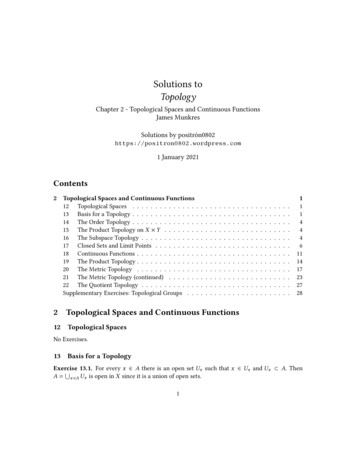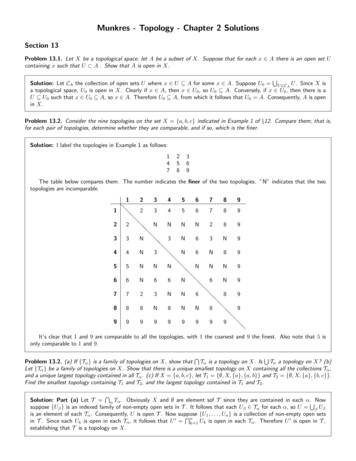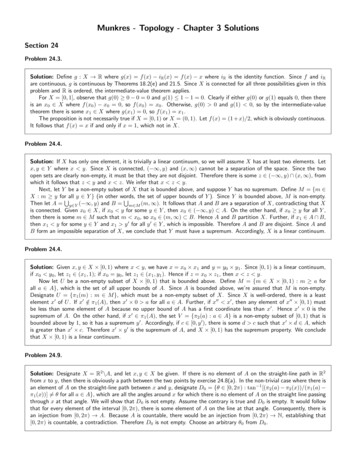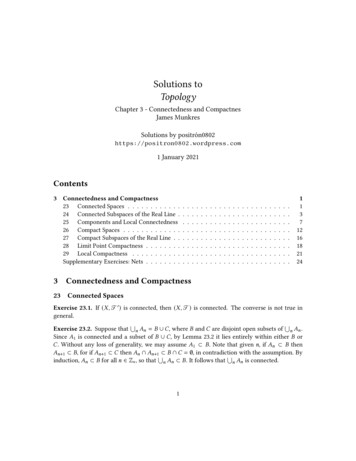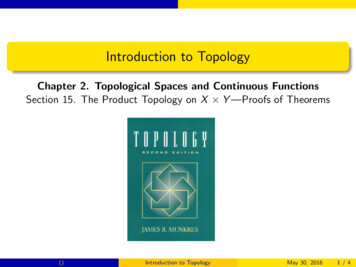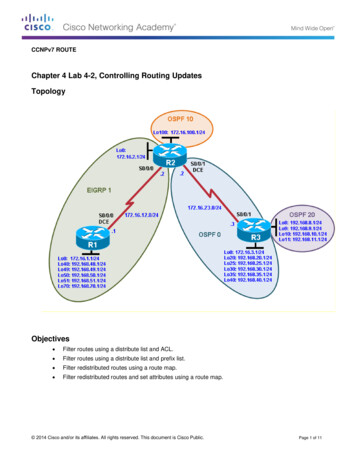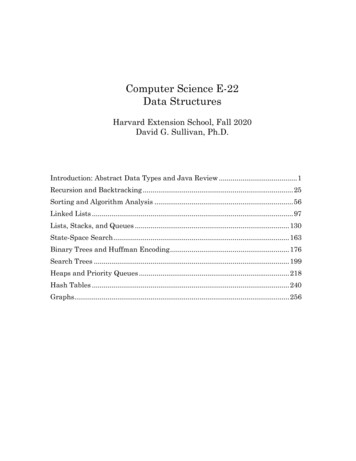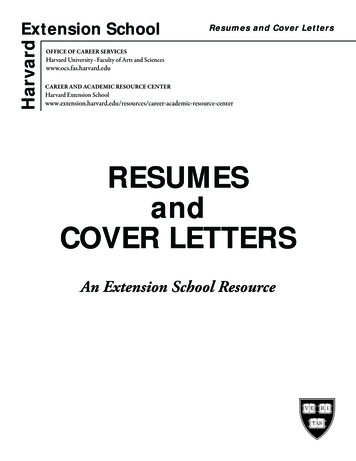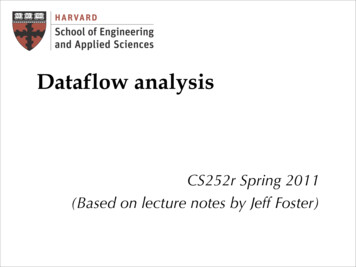
Transcription
TopologyCourse Notes — Harvard University — Math 131Fall 2013C. McMullenContents1234567891011121314151Introduction . . . . . . . . . . . . . . . . . . . .Background in set theory . . . . . . . . . . . . .Topology . . . . . . . . . . . . . . . . . . . . . .Connected spaces . . . . . . . . . . . . . . . . .Compact spaces . . . . . . . . . . . . . . . . . .Metric spaces . . . . . . . . . . . . . . . . . . .Normal spaces . . . . . . . . . . . . . . . . . . .Algebraic topology and homotopy theory . . . .Categories and paths . . . . . . . . . . . . . . .Path lifting and covering spaces . . . . . . . . .Global topology: applications . . . . . . . . . .Quotients, gluing and simplicial complexes . . .Galois theory of covering spaces . . . . . . . . .Free groups and graphs . . . . . . . . . . . . . .Group presentations, amalgamation and gluing .1312232732414547535861667581IntroductionTopology is simply geometry rendered flexible. In geometry and analysis, wehave the notion of a metric space, with distances specified between points.But if we wish, for example, to classify surfaces or knots, we want to thinkof the objects as rubbery.Examples. For a topologist, all triangles are the same, and they are all thesame as a circle. For a two–dimensional example, picture a torus with a hole1
in it as a surface in R3 . This space can be almost completely flattened out.Indeed, it is topologically the same as a rotary with an underpass connectingits inner and outer edges.Figure 1. Rotary with underpass.If we take an ordinary band of paper and put in a twist, it becomes aMöbius band, which seems clearly different, but how so? What happens ifyou cut a Möbius band down the middle? What happens if you do it again?Is a configuration of two linked circles in space fundamentally different fromtwo unlinked circles?The idea of a topological space. The property we want to maintain ina topological space is that of nearness. We will allow shapes to be changed,but without tearing them. This will be codified by open sets.Topology underlies all of analysis, and especially certain large spaces suchas the dual of L (Z) lead to topologies that cannot be described by metrics.Topological spaces form the broadest regime in which the notion of acontinuous function makes sense. We can then formulate classical and basictheorems about continuous functions in a much broader framework.For example, an important theorem in optimization is that any continuousfunction f : [a, b] R achieves its minimum at least one point x [a, b].This property turns out to depend only on compactness of the interval, andnot, for example, on the fact that the interval is finite–dimensional.Invariants. A second agenda in topology is the development of tools to telltopological spaces apart. How is the Möbius band to be distinguished fromthe cylinder, or the trefoil not from the figure–eight knot, or indeed how isR3 different from R4 ? Our introduction to the tools of algebraic topologyprovides one approach to answer these questions.2
This course. This course correspondingly has two parts. Part I is point–set topology, which is concerned with the more analytical and aspects of thetheory. Part II is an introduction to algebraic topology, which associatesalgebraic structures such as groups to topological spaces.We will follow Munkres for the whole course, with some occassional addedtopics or different perspectives.We will consider topological spaces axiomatically. That is, a topologicalspace will be a set X with some additional structure. Because of the generality of this theory, it is useful to start out with a discussion of set theoryitself.Remark on writing proofs. When you hit a home run, you just have tostep once on the center of each base as you round the field. You don’t haveto circle first base and raise a cloud of dust so the umpire can’t quite see ifyou touched the base but will probably give you the benefit of the doubt.2Background in set theoryThe axioms of set theory. Axiom I. (Extension) A set is determined by its elements. That is, ifx A x B and vice-versa, then A B. Axiom II. (Specification) If A is a set then {x A : P (x)} is also aset. Axiom III. (Pairs) If A and B are sets then so is {A, B}. From thisaxiom and 0, we can now form {0, 0} {0}, which we call 1; andwe can form {0, 1}, which we call 2; but we cannot yet form {0, 1, 2}.S Axiom IV. (Unions) If A is a set, then A {x : B, B AS& x B}is also a set. From this axiom and that of pairs we can form {A, B} A B. Thus we can define x x 1 x {x}, and form, for example,7 {0, 1, 2, 3, 4, 5, 6}. Axiom V. (Powers) If A is a set, then P(A) {B : B A} is also aset.3
Axiom VI. (Infinity) There exists a set A such that 0 A and x 1 A whenever x A. The smallest such set is unique, and we call itN {0, 1, 2, 3, . . .}. Axiom VII (The Axiom of Choice): For any set A there is a functionc : P(A) { } A, such that c(B) B for all B A.Discussion of the Axioms. Axiom I. (Extension). To have a well–defined domain of discourse, the elements of sets are also sets.There is a subtle point in Axiom I: what does the conclusion, A B,mean anyway? In fact the idea of equality is a notion in logic rather thanset theory. It means that for any logical sentence P (x), P (A) has the sameanswer as P (B). For example, if A B, and A Y , then B Y .Axiom II. (Specification). Examples: A B {x A : x B}.A B {x A : x 6 B}. R Q irrationals; Q R .{x Z : y Z, y y x} even numbers.{x Z : x/n Z n 0} {0}.{x Z : x2 0} .For more advanced set theory, one uses the Axiom of Replacement insteadof Specification; this permits the construction of cardinals such as ℵω , but itis not required for most ‘mainstream’ mathematics.Assuming at least one set A exists, we can now form0 {x A : x 6 x},but nothing else for sure. (E.g. A might be .)The Barber of Seville; Russell’s paradox. If X {A : A 6 A}, isX X? There is no universe: given a set A, set X {B A : B 6 B}.We claim X 6 A. Indeed, if X A, then X X iff X 6 X.One solution to the classic paradox — who shaves the barber of Seville?— is of course that the barber is a woman. In the Gödel-Bernays theory, youare allowed to form X, but X is not a set; it is called a class.Axiom III. (Pairs). From this axiom and 0, we can now form {0, 0} {0}, which we call 1; and we can form {0, 1}, which we call 2; but we cannotyet form {0, 1, 2}.4
AxiomIV. (Unions). From this axiom and that of pairs we can formS{A, B} A B. Thus we can define x x 1 x {x}, and form, forexample, 7 {0, 1, 2, 3, 4, 5, 6}.TIntersections. If A 6 , we can define T A {x : B A, x B}. SinceA has at least oneT element B0 , we have A B0 and thus the intersectionis a set. Note: T is undefined!TExamples: {A} A, {A, B} A B.Axiom V. (Powers) Examples: X {B P(52) : B has exactly 5 elements}is the number of possible poker hands. X 2, 598, 960.Pascal’s triangle. The subsets with k 1 elements of {1, . . . , n} can bepartitionedinto those that include n and those that do not. Thus n 1 k nn .kk 1Axiom VI. (Infinity) . We have now built up the natural numbers via settheory, and can proceed to the real numbers, functions on them, etc., witheverything resting on the empty set.Another standard assumption we have not listed is the Axiom of Extension, which asserts there is no decreasing sequence . . . x3 x2 x1 . Thisimplies all sets rest on the empty set, and we never have the infinite loopx x.A kindly mathematician uncle asks his niece, “What’s the highest numberyou know?” The niece replies, “168,000,000”. The uncle asks, “But what about168,000,001”? And the niece replies, “I was close, wasn’t I?” (Hubbard)Moving along. We can now define ordered pairs by(a, b) {{a}, {a, b}}.Then (a, b) (a0 , b0 ) iff a a0 and b b0 . Then we can define the product oftwo sets byA B {(a, b) : a A, b B}.Note that A B P(P(A B)), so it is a set.Relations. A relation R between A and B is a subset R A B. It has adomain and range.A relation can be visualized as a directed graph with vertices A B andwith an edge from a to b exactly when (a, b) R.Examples: an equivalence relation is a subset of A A with certainproperties. The relation i j on Z. The relation b a on {1, 2, . . . , 10}.5
Functions. A function f : A B is a relation between A and B such thatfor each a A, there is a unique b such that (a, b) f . We write this asb f (a). Functions are also called maps.The set of all f : A B is denoted B A . Why? How many elements does53 have? (Answer: 243.)A function can be injective and/or surjective. It is bijective if both.Composition of maps: f g. If f : A B is bijective, then there is aunique map g : B A such that g f (x) x x A.Examples: f (n) n2 is injective on N, but not on Z. It is surjective inneither case. The function sin : R [ 1, 1] is surjective but not injective.Its restriction, sin : [ π/2, π/2] [0, 1], is bijective. Its restriction, sin :[0, 1] [ 1, 1], is injective but not surjective.Set theory as a programming language. The point of the definitions ofN and (a, b) is not so much that they are natural or canonical, but that theywork. In other words set theory provides a very simple language in whichthe rest of mathematics can be implemented.There is a natural bijection between A A and A2 .There is a natural bijection between P(A) and 2A .P(X) as an algebra. If we define A · B A B and A B (A B) (A B), then P(X) becomes a ring. The identity elements are and X.This rings is nothing but the ring of map f : X Z/2.Note that A A 0. Thus this ring is also an algebra over the field F2 .We letχ : P(X) 2Xdenote the map that sends A to its indicator function χA which is 1 on Aand otherwise zero.Functions, unions and intersections. Let f : X Y be a function. Weset f (A) {f (a) : a A}. In this way we obtain a map f : P(X) P(Y ).Is this map a ring homomorphism?In general, f (A B) 6 f (A) f (B). We only have f (A B) f (A) f (B).However, if f is injective, then equality holds. We always have, however,f (A B) f (A) f (B).If f : A B is a function, for any subset X B we define f 1 (X) {a A : f (a) X}. Thus we have f 1 : P(B) P(A). This map preservesintersection and unions: e.g. f 1 (X Y ) f 1 (X) f 1 (Y ).Abusing notation, one also writes f 1 (b) for f 1 ({b}).6
The ubiquity of f 1 . The fact that f 1 preserves set-theoretic operationsmeans that a good theory of maps often turns on properties of f 1 ratherthan f .For example, we will see that a continuous function can be defined asone such that f 1 (U ) is open for every open set U . Similarly a measurablefunction is one such that f 1 (U ) is measurable for every open set U .Another reason for this ubiquity is that functions naturally pull back. Inparticular, the indicator functions satisfyχA f f (χA ) χf 1 (A) .This pullback operation preserves the algebra structure of the space offunctions. In differential topology, we find that forms pullback as well, thatd(f ω) f (dω), etc.Cardinality and the Axiom of Choice. We say sets A and B have thesame cardinality if there is a bijection between A and B. We will write thisrelation as A B . It is an equivalence relation.Theorem 2.1 N 6 R .Proof. Suppose x(n) is a list of all real numbers, and write their fractionalparts as{xn } 0.x1 (n)x2 (n) . . .in base 10. Now choose any sequence of digits yi with yn (n) 6 xn (n). Wecan also arrange that yi is non-repeating. Theny 0.y1 y2 y3 . . .disagrees with xn in its nth digit, so it is not on the list.Theorem 2.2 (Cantor) . A and P(A) do not have the same cardinality.Proof. Given f : A P(A), let B {a : a 6 f (a)}. Suppose B f (a).Then a B iff a 6 B. This is a contradiction so f does not exist.7
If we think of P(N) 2N as sequences (ai ) of binary digits, then the proofthat N 6 P(N) is almost the same as digit diagonalization.Corollary 2.3 There are many different sizes of infinity.Finite sets. A set A is finite iff there is a bijection f : A n for somen N. That is, A is finite iff A n for some n N.Theorem 2.4 (Pigeon-hole principle) If A is finite, then any injectivemap f : A A is surjective.Proof. By induction on A n.Application: for any prime p and a 6 0, there is an integer b such thatab 1 mod p. (I.e. b 1/a). Proof: The map b 7 ab is 1 1 on Z/p, so itis onto. Example: 1/10 12 mod 17; in fact 10 12 120 7 17 1.Infinite sets. A set is infinite iff it is not finite.Theorem 2.5 N is infinite.Proof. Otherwise, there would for some n be an injective map N , n,and hence an injective map n 1 , n. This contradicts the pigeon–holeprinciple.Axiom VII (The Axiom of Choice). For any set A there is a functionc : P(A) { } A, such that c(B) B for all B A.In concrete cases it is possible to find explicit choice functions. For thenatural numbers, we can let c(A) min(A). For the rational numbers, wecan take this ‘simplest’ rational number x p/q in A, say with q minimal, p minimal given q, and with x 0 to break ties.The smallest infinite set. Here is typical use of the Axiom of Choice.Theorem 2.6 A is infinite iff there is an injective map f : N A.Proof. If A is finite then any subset of A is finite, so there is no injection ofN into A.Now assume A is infinite; we will construct f . Pick some a A. Thendefine, by induction, f (0) a and f (n 1) c(A {f (0), . . . , f (n)}). Theresulting map is injective by construction.8
Cantor’s definition of infinity. A set A is infinite iff there exists a mapf : A A which is injective but not surjective.The proof uses the Axiom of Choice: first embed N into A, and then usex 7 x 1 on N.Hilbert’s
set topology, which is concerned with the more analytical and aspects of the theory. Part II is an introduction to algebraic topology, which associates algebraic structures such as groups to topological spaces. We will follow Munkres for the whole course, with some occassional added topics or di erent perspectives. We will consider topological spaces axiomatically. That is, a topological space .
